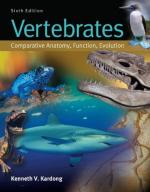|
This section contains 555 words (approx. 2 pages at 300 words per page) |

|
There are many forms of evidence for evolution. One of the strongest forms of evidence is comparative anatomy; comparing structural similarities of organisms to determine their evolutionary relationships. Organisms with similar anatomical features are assumed to be relatively closely related evolutionarily, and they are assumed to share a common ancestor. As a result of the study of evolutionary relationships, anatomical similarities and differences are important factors in determining and establishing classification of organisms.
Some organisms have anatomical structures that are very similar in embryological development and form, but very different in function. These are called homologous structures. Since these structures are so similar, they indicate an evolutionary relationship and a common ancestor of the species that possess them. A clear example of homologous structures is the forelimb of mammals. When examined closely, the forelimbs of humans, whales, dogs, and bats all are very similar in structure...
|
This section contains 555 words (approx. 2 pages at 300 words per page) |

|


